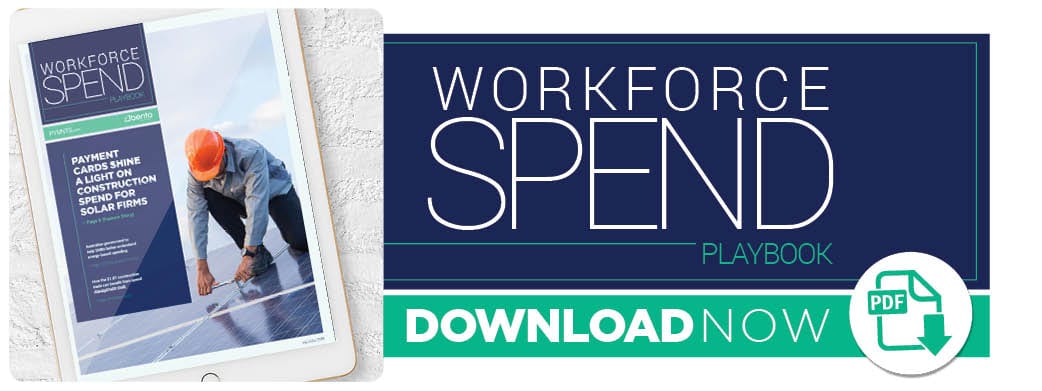Payment Cards Shine A Light On Construction Spend For Solar Firms

The solar energy market’s rapid growth has many field-based solar technicians finding themselves on shaky financial ground when making expensive out-of-pocket purchases for a job. In the new Workforce Spend Playbook, Tom Skraby and Kathryn Giliberto of Borrego Solar Systems discuss how spend cards and monitoring solutions help retain employees and keep projects on track.
Solar energy consumption is on the rise in the U.S. and is expected to increase another 20 percent by next year. This boom in popularity is partly because the overall cost of solar panels and installment is going down, making them a more sustainable option for construction projects.
Solar, wind and hydropower will be responsible for about 19 percent of electricity production in the U.S. by 2020, according to some projections, keeping such companies busy in both residential and commercial applications. Solar construction and installation firms must ensure their cash flows remain steady as the industry expands, which means addressing the costs related to construction, safety equipment, diesel and other fuel, as well as any unexpected expenses.
Field-based supervisors and contractors frequently wind up footing the bill for work-related costs, and lengthy reimbursement processes can put undue strain on individual workers and projects. Credit cards can partially solve this problem, but issuing them to a legion of supervisors, subcontractors and workers presents another set of issues, including fees.
This is why solar installation company Borrego Solar Systems is managing expenses with payment cards instead. Tom Skraby, the company’s vice president of finance, explained that expense management company Bento for Business’ payment cards have helped its field-based workers avoid work-related expenses and kept projects moving.
“The [contractors] don’t have the [funds] to front the money,” Skraby said. “It’s either use the card or it doesn’t happen.”
In a recent interview with PYMNTS, Skraby and Kathryn Giliberto, Borrego’s senior treasury manager, discussed how payment cards help the firm stay focused on energy installations rather than employee reimbursements.
How Payment Cards Can Help Overcome Cost Challenges, Ease Financial Distress
Borrego designs, engineers and builds commercial solar power systems in California, Massachusetts and New York, and now relies on payment cards to ease pain points in its spend management process. The company previously kept projects moving by requiring workers to pay out of pocket and wait weeks for reimbursements.
Giliberto explained that the cards simplify contractors’ average on-site payments.
“A typical [expense] would be needing something at Home Depot,” she said, adding that Borrego’s usual payment process involves putting in a construction request, which other parties need to approve before an invoice is issued. “But places like Home Depot, they’re not going to issue an invoice like that. [Contractors] need to actually go to the store and [make] the payment.”
Issuing payment cards to construction supervisors and relevant contractors enables Borrego to bypass lengthy processes that require employees to submit expense reports and wait until reimbursements align with biweekly payroll cycles. Payment cards enable the company to keep projects on track when contractors or supervisors might not have credit cards on hand to make field-based purchases.
“[If] they don’t have credit, they don’t have anything,” Skraby said. “If they don’t have a [payment] card, they won’t make the purchase. If they need some gasoline for the project, they don’t get the gasoline. It’s really something where we have to take care of them in the field.”
The alternative to the cards is to place orders with vendors, delaying projects until products are delivered.
“They have to wait until we order it from a corporate vendor and then the product is shipped to them,” Skraby explained.
Flexing Spend Controls
Borrego can set daily spend limits on the payment cards and restrict what can be purchased. Workers can use the accompanying Bento for Business app to track budgets and upload receipts, preventing them from having to file expense reports. Purchases that fall outside of Borrego’s parameters or go over the daily limit are automatically declined, Giliberto noted.
Another draw for the cards is the ability to categorize and monitor purchases in a way that does not impact projects or cash flow. Borrego can set controls to ensure funds are spent appropriately, an option that is not available on traditional credit cards.
“One of the options was to do a credit card, but we couldn’t do that because we didn’t want to have a massive amount of credit cards open,” Giliberto said. “The [payment cards] seemed like a good idea because of the way we can set these parameters.”
She added that Borrego has a process in place to ensure that only approved contractors receive cards.
Administrative Changes and New Technologies
Giliberto noted that the cards must be balanced with a thorough administrative review to ensure that all field-based spending is above-board. This includes requiring receipts to be uploaded using a mobile app.
“You do need a good monitoring system,” she said. “It can’t be a free for all. I have to monitor it, and if they’re not uploading their receipts, I have to reach out [to] them … in the field.”
The main benefit of such a cost management system is that it removes financial stress for both field-based contractors and the company, Giliberto added. Workers are spared from having to make out-of-pocket expenses, which can save time, and administrators can review how funds are spent.
Field-based workers will increasingly be called upon to make installations as the solar energy market expands. Payment cards and cost management solutions can help workers finish projects and shed light on opportunities to make installations more efficient.
